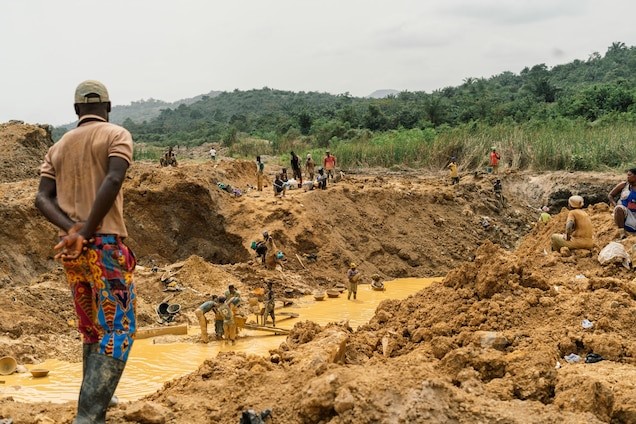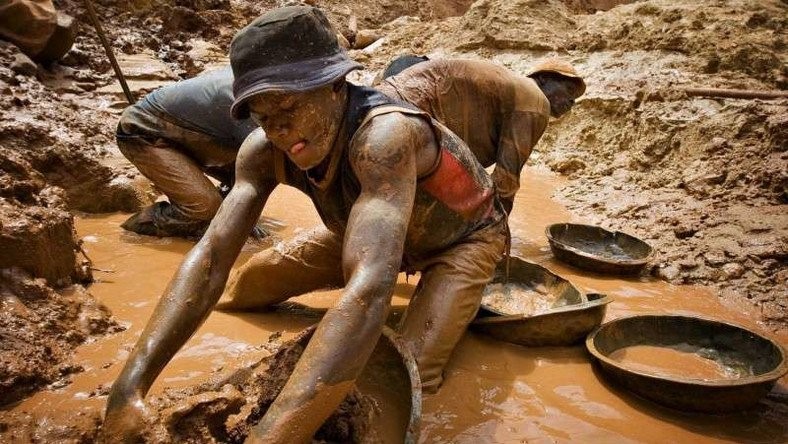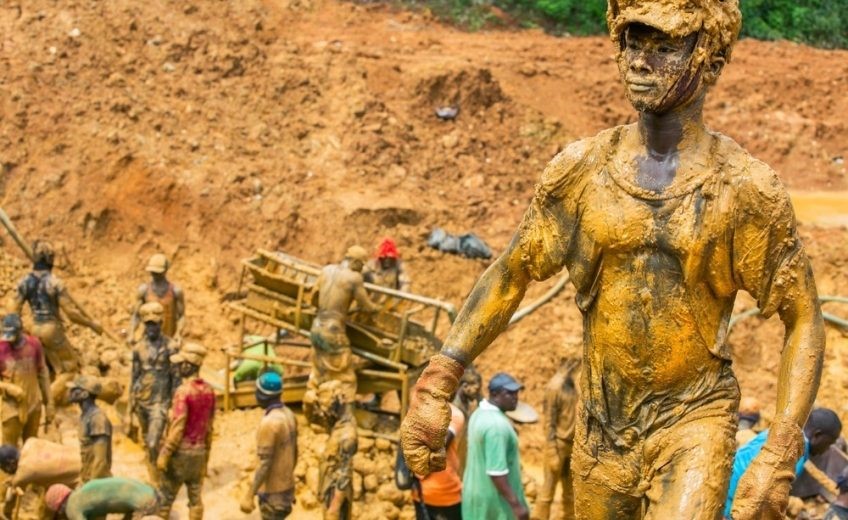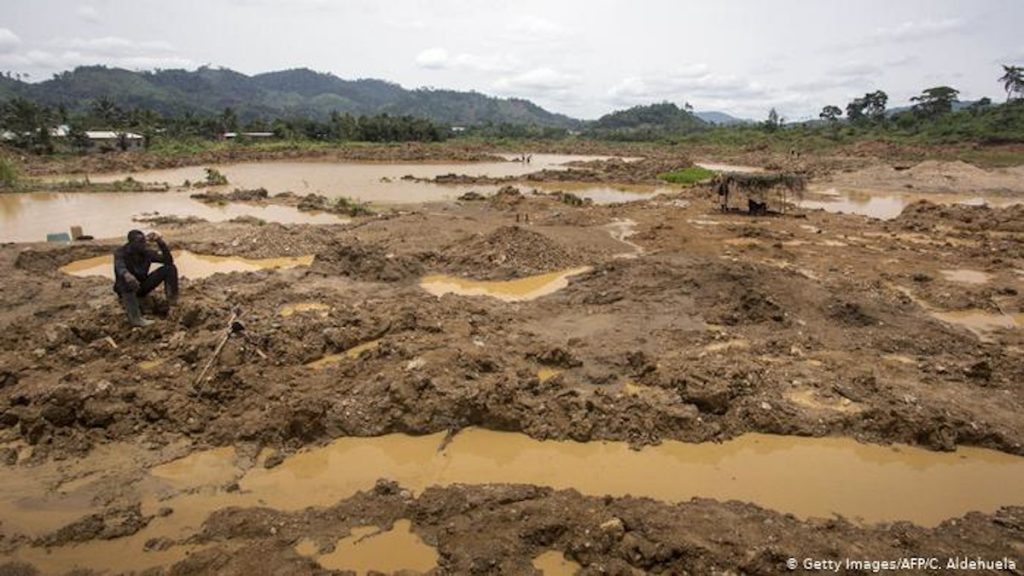
Kojo William grabbed his machete and trekked through the bush to his cocoa farm through winding pathways and hills, past ominous pits of muddy water, and underneath the low-hanging canopy of dried cocoa leaves. But the trees were bare. A few rotting cocoa pods littered the ground, while other stunted pods refused to ripen on the branches.
“When the Chinese came, they told me that my plants were not yielding anymore because there was so much gold under the soil,” William told Business Day in an interview. After a few years of low production, he sold his 14 acres to a group of illegal small-scale gold miners, also called galamsey miners, with a Chinese sponsor. The money is gone now and William’s land is poisoned.
Kojo William’s story is not uncommon in Denkyira Asikuma, a small farming village nestled amongst cocoa plantations outside of Dunkwa in Ghana’s Central region. At least 30 cocoa farmers in the village have sold their land to miners who quickly excavated, pumped in water and chemicals, and abandoned their pits when the work was done or when soldiers chased them away.
Although Ghana has had a formalised process for engaging in ASM on legal basis since the late 1980s, an estimated 85 percent of small scale miners in the country operate on illegal basis. Popularly known as galamsey, illegal mining has had significant adverse implications in Ghana, ranging from revenue losses to the state as illegal miners do not pay taxes to the pollution of important water bodies.
Gold mining has always been a part of Ghana, from the ornate jewelry of the Ashanti kings to British colonization. In the last several years, however, largely unregulated illegal mining known in Ghana as ‘galamsey’ mining has ramped up due in part to Chinese investors who bring sophisticated equipment and a lagging economy that makes the prospect of striking gold too sweet to pass. These often, illegal operations do result in contaminated water, deforestation, and a rise in violent crime.
Illegal gold mining in Ghana further exacerbates a volatile cocoa market. In 2014, experts predicted a global cocoa shortage by 2020. However, cocoa production statistics have been unpredictable since then, according to the most recent data from the 2015-16 growing season. That year, there was a cocoa surplus, attributed to a prolonged rainy season. Recently, the price of the bean has plummeted to historic lows on global commodity exchanges—negatively impacting the profits of West African cocoa farmers.
In 2011, Ghana produced a record-setting amount of cocoa, weighing in at over one million tonnes. Since then, as illegal mining steadily ramped up, cocoa production has trended downwards, with a drop to 740,000 tonnes in 2015.
“Galamsey is the biggest threat to cocoa production,” Pomasi Ishmael, the chairman of a cocoa buyers’ collective, told Business Day Media.
Several other factors have been blamed for the volatile nature of the cocoa market, most notably climate change, which can usher in an extremely dry season one year and excessive rain the next. Deforestation from illegal gold mining may speed up such effects.

Gold and cocoa are both integral parts of Ghana’s economy and national identity, yet the two resources’ coexistence has contradictions. Cocoa was first planted in Ghana in the 1870s, and the former Gold Coast colony became the largest exporter of the chocolate-making beans for the next century, until neighbouring Ivory Coast surpassed them.
Two decades after the arrival of cocoa, the legal Obuasi gold mine was founded. Closely regulated, the big industrial operation transformed a small Ashanti village into a cosmopolitan city with tennis courts and golf clubs.
For decades, miners toiled underground in the sprawling complex. Today, the mine is no longer producing gold and galamsey miners have quickly filled the void, wiping away cocoa farms in their path.

The Conflict’s Ground
The single-lane highway from Obuasi to Dunkwa is lined on both sides with a string of excavating machines and gold-washing outposts. Immediately after passing the town’s tollbooth, signs advertising gold dealers and mining equipment—in both English and Chinese—crowd the streets, vastly outnumbering the fading billboards for cocoa fertilizer.
Dunkwa sits on the Offin River, a tributary of the Pra River, which is one of the largest river systems in Ghana. In the last few years, these water bodies have turned an alarming yellow colour, due to chemical wastewater from illegal gold mining, unrecognizable from their former resilient blue.
The area covered by the Pra River Basin—including parts of Ghana’s Central, Western, and Ashanti regions—is the country’s cocoa heartland. It also holds the highest concentration of gold deposits. Ghana is the world’s second largest cocoa exporter, contributing 20 percent of the world’s supply. More than 70 percent of cocoa beans come from West Africa.

It’s unlikely that Kojo William’s cocoa farm was spoiled due to the gold underneath its soil, as the miners claimed. It’s much more likely that his cocoa crops were negatively affected by the increase of galamsey activities in the area, which can poison waterways with heavy metals and chemicals like lead, mercury, and cyanide, as well as unpredictable rainy and dry seasons attributed to climate change.
The Mercury Connection
Over 5,000 people work at the Adumanu galamsey site, most of them without legal permits, according to Joseph Owusu Sekyere, who owns several pits. Just a few miles outside of Obuasi, the yellow holes filled with brackish water are ubiquitous.
Massive amounts of stones are crushed into sand and washed at these sites, which take water from nearby river systems and deposit wastewater back into them.
“We use mercury to get the gold,” Sekyere said. “I’ve heard of people using cyanide and other chemicals to process stones too.”
In 2014, Ghana was one of the 18 countries to sign the Minamata Convention on Mercury at the UN General Assembly, with the intention of minimizing mercury exposure to the population. However, mercury use in galamsey mining continues.
The Minerals Commission of Ghana focuses on maintaining the environmental standards of larger companies, while small-scale operations often fall through the cracks. Last year, the government declared a “war on galamsey”—arresting a few miners and making showy displays of destroying some equipment—but many operations continue.
Mercury exposure is especially harmful to children and teenagers, who often work at galamsey sites and handle the liquid metal with their bare hands. Mercury poisoning also affects people who live near galamsey sites through drinking water and fish consumption. Neurological disorders are associated with mercury poisoning, and it is particularly harmful to pregnant women. Additionally, it can wipe out entire plant populations and stunt crop growth, including cocoa.
Years ago, urban residents traveled to the villages surrounding Obuasi and Dunkwa for fresh fish and bountiful produce. Nowadays, people in Obuasi say many villagers are forced to come to town to buy food because they can’t sustain their farms.
Deadly Work
Further into the galamsey site at Adumanu, past a makeshift market and through a forest, the landscape is pockmarked with holes. They are less than three feet wide but stretch up to 2,000 feet into the belly of the Earth. The dangers of mercury poisoning are often not the most immediate concerns here.
“The first day I went underground I thought that I wouldn’t come out again. I cried the whole time,” said Boakye Andrews, a galamsey miner. “Look at it this way: 10 or 15 MTN poles (cell phone towers) stuck on top of each other. That’s how deep we go.”
A professional miner drives past a statue dedicated to his trade in Obuasi. A massive, historic mine passes under the whole town and has long been the basis for its economy. The legal mine has struggled in recent years but plans to expand operations again soon.
Five hundred or more illegal miners descend into the Adumanu pits daily. They chisel stones and bring up heavy sacks through an assembly line. Some workers stay underground for a few days, others for over a month, bringing along water, rice, and cooking oil. Frequently, galamsey workers die underground due to flooding or unsafe use of dynamite.
“Anytime somebody dies [underground], the person will blast into pieces,” Andrews said. “If you are about 20 and five die on the spot, you still keep on working because the gold has to come up to the surface. So you ignore the accident and keep working. He’s dead. You can’t do anything about it.”
Although news reports of galamsey accidents, often with fatalities in the teens, were frequent throughout last year, the true death toll remains unknown. In 2010, one mining accident near Dunkwa killed an estimated 150 miners. Most deaths are not officially recorded because family members are ashamed or worried about prosecution.
Andrews started working in galamsey when he was 19, almost a decade ago, but was raised with mining long before that. His father worked at the big Obuasi mine, then called AngloGold Ashanti, in its heyday. He passed away when Andrews was eight years old.
“I grew up in Obuasi,” he said. “When I was young, every time I saw them doing this galamsey work I said ah…what’s wrong with them? When it came to my turn, I realized that it wasn’t their fault, because they were not getting help from anywhere.”

Violent Occupation
The Obuasi mine, which has changed ownership several times since its founding in 1897, has always been the lifeblood of the city. Until the late 2000s, Obuasi was one of the most affluent towns in Ghana, boasting a sports club with swimming pool, tennis courts, and cricket pitch, as well as a first-class hospital and school—all funded privately by the mine. The town was cosmopolitan and diverse. The children of European mine workers attended the same schools as Ghanaians.
Young people like Andrews had always assumed they would work for the company in some capacity, just as their parents did. However, in 2014, AngloGold Ashanti suspended gold production in Obuasi due to financial constraints, laying off more than 90 percent of its workforce and spending $210 million on severance packages. The entire economy of the city fell into decline. Signaling a possible upturn, AngloGold Ashanti announced that they would resume gold production at the Obuasi mine in 2019. But there is a steep climb to rebuild Obuasi’s former economic glory.

In the time since the mine’s decline, some former miners turned their skills to galamsey work, even if they couldn’t secure legal permits. One example is Owusu Sekyere, the pit owner at Adumanu, who had worked for AngloGold for over 20 years.
In January 2016, illegal miners stormed the AngloGold Ashanti Obuasi mine, capturing control of the intricate tunnel network that snakes under the city, a mile below the surface. On the second day of the incursion, an AngloGold senior manager was killed. The Army was eventually called in, which clashed with the miners for weeks. By the end of the occupation, at least 175 galamsey miners had died.
“It’s common knowledge in the country… we all know that the illegal mining activity has been on the increase,” said Eric Asubonteng, the managing director of AngloGold Ashanti Obuasi mine.
While AngloGold Ashanti’s mining activities were under strict regulations from Ghana’s Environmental Protection Agency and Minerals Commission, illegal miners often go unregulated, he said.
“Our impact on the environment is not something we should be putting in the same box or bracket as the illegal miners,” Asubonteng said. He added that even water discharged from the underground mine has to get treated. “But we don’t have any way or any approach to regulate the illegal miners. Then all our efforts come to nil.”
In the course of their occupation, illegal miners damaged water treatment and electrical infrastructure in AngloGold’s Obuasi mine, setting them back at least a year in feasibility studies and much further in terms of investor confidence, according to Asubonteng. This was critical at a time when the mine was looking for new investors to resume full operations—which could help revive the economy in Obuasi.
A month after the invasion, AngloGold Ashanti surrendered 60 percent of its land concession to the government of Ghana. Some of that land, already identified to be rich in gold, was officially leased to galamsey miners in an effort to regulate their operations. It remains unclear how environmental regulations are being followed on these newly legal sites, although anecdotal evidence suggests bribes may be favoured over inspections.

Policy Challenges
One of the most significant policy challenges in Ghana today revolves around the question of how best to maximise the benefits of the artisanal and small-scale mining (ASM) sector while minimising the negative consequences associated with it.
Today, ASM accounts for well over 60 percent of Ghana’s total mining labour force, providing direct and indirect employment to over one million people. In 2013, gold exports from ASM operators accounted for 34 percent of Ghana’s total gold export, which equalled the total contribution of the three largest multinational companies in the country.
Business Day’s investigations revealed that three key political issues are especially crucial the fight against the menace: the nature of electioneering campaigns, the network of powerful actors engaged in this phenomenon and the challenge this poses for the effective enforcement of anti-galamsey laws, and ambiguities around land tenure practices.
The galamsey discourse has taken an increasingly partisan character in which opposition parties often bolster the position of illegal miners in order to make those in power unpopular and gain partisan political advantage. The two dominant parties are especially guilty of this problem. In late 2006, the NPP government initiated Operation ‘Flush-Out’ – a military ‘sweep’ against illegal miners that resulted in the confiscation and destruction of the equipment of galamsey operators.
This operation formed an important part of the campaign message of the opposition NDC which campaigned on a platform that was sympathetic to small-scale mining youth engaged in galamsey. The late Professor John Atta Mills, NDC presidential candidate in 2008, continually blamed the leadership of the then ruling NPP for conflicts between small-scale miners and large-scale companies, and reportedly asked why the NPP was treating galamsey operators as if they were ‘not Ghanaians’.
Once Atta Mills won the 2008 elections, his government came under intense pressure from youth groups and small-scale miners to make good on his promises to provide greater support for the sector. The NPP, now in opposition, capitalised on the small-scale mining community’s perceived alienation in the next elections by pointing fingers at Mills’ broken promises.
Importantly, just as the NDC did in 2008, the NPP’s campaign strategy for the 2016 elections was couched in a language that pointed to its support for galamsey, even if unintentionally. During a campaign trip to Obuasi, the party’s presidential candidate, now President Akufffo Addo reportedly drew his supporters’ attention to how the Mahama-led NDC government “directed Soldiers to come and drive out all persons involved in galamsey”.
“It is these types of election favour pronouncements that provided grounds for galamsey operators to express their feelings of betrayal by the current NPP government in its fight against illegal mining” Dr. Abdul-Gafaru Abdulai, a Senior Lecturer at the University of Ghana Business School, told Business Day Media.
Given the adverse implications of galamsey on the Ghanaian society as a whole, Dr. Abdulai, said it will be important that political parties desist from pronouncements that implicitly underscore their endorsement of illegal mining activities during election seasons.
Galamsey operators are aware of the importance of their votes for incumbent political parties, and have often exploited the political vulnerability of those in power due to intense electoral competition during election years. Around the 2016 elections, galamsey miners set off to vandalise the offices of various political parties amidst chants of “no galamsey, no votes”.
Illegal miners have recently repeated such threats, asking President Akuffo Addo to halt his fight against their operations or risk being voted out of power in 2020.
Until quite recently, most analysts and policy makers have interpreted Ghana’s galamsey menace as a technical and economical and not a political problem driven by the cumbersome and time-consuming processes involved in acquiring the necessary licenses for engaging in small-scale mining on legal basis; widespread poverty and youth unemployment in rural areas; and perceived social injustices resulting from the displacement of indigenous communities by large-scale expatriate mining companies.
Consequently, efforts in curbing the galamsey menace have focused largely on the provision of technocratic solutions such as simplifying and decentralising the small scale-mining licensing regime, the provision of alternative livelihood opportunities for displaced communities and small-scale miners, the demarcation of land plots reserved for small scale mining operators, and some occasional ‘military crackdowns’ where armed security forces raid the sites of miners to arrest them and confiscate their assets.
But Dr. Abdulai, who is also an Honorary Research Fellow at the Global Development Institute, University of Manchester, UK said “all these approaches have failed, as evidenced in the growth of illegal mining activities and its adverse implications.”
Illegal mining has also persisted in Ghana not because of weak state capacity, as some have claimed, but primarily because of political leniency and law enforcement corruption, Dr Abdulai alleged, while attributing the galamsey phenomenon to “a complete lack of political will.”
He argued that the people who have the responsibility to curb illegal mining activities tend to benefit from them, adding that, the chiefs are culpable, the Assemblies are culpable, some MPs are culpable, and some ministers are culpable. Some chiefs, he noted, gain through the royalties they receive in exchange for land; and the political, business, and local elite who own the concessions that operate outside the legal mining framework.
“That is how bad it is,” he lamented.
Looking Ahead
Meanwhile, members of COCOBOD, Ghana’s government-owned singular cocoa exporter, and cocoa farmer unions have publicly criticized galamsey as the single biggest threat to cocoa farming in the country. They point out that cocoa exports have long been closely tied to the country’s economic status, so much so that cocoa beans are emblazoned on its currency.
“What’s happening in terms of illegal mining in Ghana—let’s think beyond Obuasi—is something that if we are not careful will get to a point that we will lose it totally,” Asubonteng said. “The damage caused by illegal miners in terms of environment, in terms of child labour, in terms of the impact on health of communities, the impact of law and order is significant,” he added.
Ghana’s galamsey crisis has yet to affect global chocolate prices in a noticeable way, but the future implications may be seen in the current reality of Kojo William’s cocoa farm. His 14 acres of once-vibrant cocoa trees, and that of at least 30 farmers in his village and exponentially more farmers in the region, have been replaced with scars on the Earth.

Unless the illegal mining is completely stopped and cocoa farms are left alone, within 10 years Ghana’s cocoa productivity could fall by half, says Daniel Sarpong, economist and head of the University of Ghana’s department of agricultural economics and agribusiness.
“It has severe consequences for our foreign exchange earning capacity and then it could further reduce the contribution of agriculture to the GDP,” he added.
If Ghana’s production does fall by half and the industry isn’t bolstered by another cocoa-producing nation, the world could be staring down the barrel of around 12.5 percent fewer chocolate bars, Sarpong says, adding that’s not taking into account growing populations or emerging markets.
“Mining destroys soil – so much so it can take 30 years for reclaimed land to be able to sustain a new cocoa farm. Miners will usually dig near water bodies, which is the same place cocoa grows,” he lamented.




























